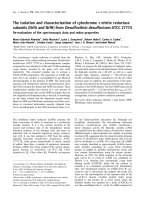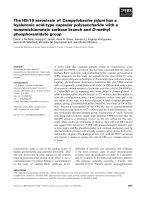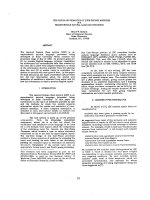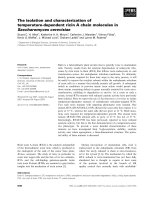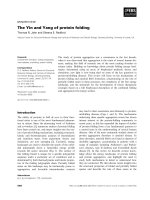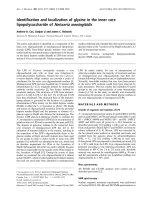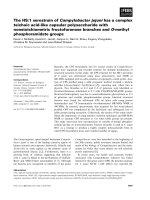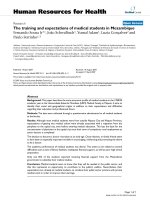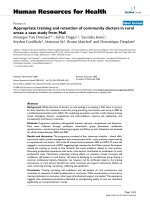báo cáo sinh học:" The distribution and transitions of physicians in Japan: a 1974–2004 retrospective cohort study" pot
Bạn đang xem bản rút gọn của tài liệu. Xem và tải ngay bản đầy đủ của tài liệu tại đây (326.12 KB, 10 trang )
BioMed Central
Page 1 of 10
(page number not for citation purposes)
Human Resources for Health
Open Access
Research
The distribution and transitions of physicians in Japan: a 1974–2004
retrospective cohort study
Hiroo Ide*
1,2
, Soichi Koike
1
, Tomoko Kodama
3
, Hideo Yasunaga
4
and
Tomoaki Imamura
5
Address:
1
Department of Planning, Information and Management, The University of Tokyo Hospital, Tokyo, Japan,
2
Department of Global Health
and Population, Harvard School of Public Health, Boston, Massachusetts, USA,
3
Department of Policy Sciences, National Institute of Public
Health, Saitama, Japan,
4
Department of Health Management and Policy, Graduate School of Medicine, The University of Tokyo, Tokyo, Japan and
5
Department of Public Health, Health Management and Policy, Nara Medical University, Nara, Japan
Email: Hiroo Ide* - ; Soichi Koike - ; Tomoko Kodama - ;
Hideo Yasunaga - ; Tomoaki Imamura -
* Corresponding author
Abstract
Background: In Japan, physicians freely choose their specialty and workplace, because to date there is
no management system to ensure a balanced distribution of physicians. Physicians in Japan start their
careers in hospitals, then become specialists, and then gradually leave hospitals to work in private clinics
and take on primary care roles in their specialty fields. The present study aimed to analyse national trends
in the distribution and career transitions of physicians among types of facilities and specialties over a 30-
year period.
Methods: We obtained an electronic file containing physician registration data from the Survey of
Physicians, Dentists and Pharmacists. Descriptive statistics and data on movement between facilities
(hospitals and clinics) for all physicians from 1974, 1984, 1994 and 2004 were analysed. Descriptive
statistics for the groups of physicians who graduated in 1970, 1980 and 1990 were also analysed, and we
examined these groups over time to evaluate their changes of occupation and specialty.
Results: The number of physicians per 100 000 population was 113 in 1974, and rose to 212 by 2004.
The number of physicians working in hospitals increased more than threefold. In Japan, while almost all
physicians choose hospital-based positions at the beginning of their career, around 20% of physicians
withdrew from hospitals within 10 years, and this trend of leaving hospitals was similar among generations.
Physicians who graduated in 1980 and registered in general surgery, cardiovascular surgery or paediatric
surgery were 10 times more likely to change their specialty, compared with those who registered in
internal medicine. More than half of the physicians who registered in 1970 had changed their specialties
within a period of 30 years.
Conclusion: The government should focus primarily on changing the physician fee schedule, with careful
consideration of the balance between office-based physicians and hospital-based physicians and among
specialties. To implement effective policies in managing health care human resources, policy-makers should
also pay attention to continuously monitoring physicians' practising status and career motivations; and
national consensus is needed regarding the number of physicians required in each type of facility and
specialty as well as region.
Published: 14 August 2009
Human Resources for Health 2009, 7:73 doi:10.1186/1478-4491-7-73
Received: 8 August 2008
Accepted: 14 August 2009
This article is available from: />© 2009 Ide et al; licensee BioMed Central Ltd.
This is an Open Access article distributed under the terms of the Creative Commons Attribution License ( />),
which permits unrestricted use, distribution, and reproduction in any medium, provided the original work is properly cited.
Human Resources for Health 2009, 7:73 />Page 2 of 10
(page number not for citation purposes)
Background
A balanced health workforce is a key factor in strengthen-
ing health care systems. Policy-makers should aim to "get
the right workers with the right skills in the right place
doing the right things" [1]. The geographical distribution
of physicians in several developed countries has been ana-
lysed in previous studies [2-4]. However, more studies are
needed in order to implement effective human resource
policies [5].
In Japan, in making their career choices, physicians gener-
ally consider the combined factors of specialty and work-
ing facility. Almost all newly-graduated Japanese
physicians become hospital-based physicians (HP), who
are employed as full-time workers by hospitals; there they
are given training to become specialists. After working for
several years, these physicians may resign from their hos-
pital positions and become self-employed, office-based
physicians (OP). In this regard, OPs are not originally
trained as general practitioners.
OPs see only primary care patients in their private offices.
They generally see patients with diseases and symptoms
that fall within their specialty area. There are few primary
care physicians who have been trained like those in the
United Kingdom, where primary care is recognized as a
specialty, and primary care physicians (general practition-
ers) are trained through a system that covers all primary
care fields. In addition, Japan does not have a compulsory
distribution system to balance the supply of physicians
around the country [3]. Since the late 1980s, administra-
tive regulation has prohibited the establishment of new
hospitals, but the establishment of new clinics and the
selection of specialties are carried out according to indi-
vidual physicians' preferences.
However, Japan is now facing a maldistribution of physi-
cians between hospitals and private clinics [6,7]. Studies
that elucidate the dynamics of physicians' career choices
among specialties and facilities are needed as a basis for
instituting appropriate human resource policies. Such
studies can also be applicable in countries facing a similar
situation to Japan's, where physicians are allowed to move
and work freely and do not have a strict specialty certifica-
tion system.
In Japan, the official survey of physician registration is the
Survey of Physicians, Dentists and Pharmacists (SPDP),
conducted once every two years. Through this survey, all
physicians are legally obliged to report their employment
status, including their workplace and position, to the Min-
istry of Health, Labour and Welfare (MHLW). For our
study, we used this retrospective data to analyse national
trends in the distribution and employment transitions of
physicians over a recent 30-year period.
Methods
Data collection
We obtained from the MHLW an electronic file containing
all the data from the SPDP from 1972 to 2004. The items
reported in the SPDP include year of registration, medical
license registration number, year of birth, gender, work-
place address, and occupation type and specialty. The data
did not include any personal information by which an
individual could be identified. Japan's Privacy Act defines
personal information as any information that any other
entities can use to identify a person or can use to do so in
combination with other sources of information.
For the present study, we organized the longitudinal data
for all physicians by retrieving their unique registration
numbers, which are given sequentially to all physicians
who pass the national examination. Then we performed
data cleansing to make the collection of data complete,
and in total 4 024 916 items of data (for 374 804 physi-
cians) were obtained. The notification rate for each imple-
mentation of the SPDP was approximately 90% [8].
Descriptive statistics
From the survey data for 1974, 1984, 1994 and 2004, we
determined the total numbers of all physicians surveyed,
along with the numbers of physicians per 100 000 popu-
lation, the percentages of physicians working at hospitals,
the percentages of female physicians, the percentages of
physicians working in rural areas and the average ages of
physicians. The national population in these years was
obtained by referring to the Japan Population Census and
the Population Estimate.
The group of physicians who graduated in 1970 was
defined as the class of 1970. The same was done for the
class of 1980 and of 1990. Some statistics, as outlined
below, were calculated starting from the physicians' fifth
year of experience.
In examining some career aspects, it is appropriate to ana-
lyse physicians' choices from the time when they became
certified in a specialty, because years of practice and case
experience are necessary before physicians can become
certified. However, the SPDP does not record specialty cer-
tification status, and physicians are allowed to present
themselves as specialists in any field, even more than one
field, according to the Physicians Law, on the sole condi-
tion that they have an active license. In our assessment of
certification status, we examined physicians' career behav-
ior from their fifth year of practice because we assumed
that they had chosen their specialties by that time.
For each of the three graduating classes, we calculated the
number of physicians in their fifth year of experience, per-
centage of female physicians in their fifth year of experi-
Human Resources for Health 2009, 7:73 />Page 3 of 10
(page number not for citation purposes)
ence, average age at first registration, percentage of
physicians working in a specialty and medical facility in
their fifth year of experience, average lifetime frequency of
specialty changes since their fifth year of experience, and
percentage of physicians changing specialties more than
once. A comparison of average values between two classes
was performed by means of a t-test, and a comparison of
rates between two classes was performed by means of a
Chi-square test.
Analysis of movement from hospital-based to office-based
practice
The numbers of physicians registered as HPs in 1974,
1984, 1994 and 2004 were defined as N1, N2, N3 and N4,
respectively. In N1, the number of HPs who withdrew
from hospital work between 1975 and 1984 was defined
as R1, and the number of HPs who remained in hospital
work during that period was defined as C1. The number
of new graduates who began to work in hospitals between
1975 and 1984 was defined as P1. In the same way,
between 1984 and 1993, and 1994 and 2003, the num-
bers of HPs who withdrew from hospital work were
defined as R2 and R3, respectively; the numbers of HPs
who remained in hospital work were defined as C2 and
C3, respectively; and the numbers of physicians who
began to work in hospitals were defined as P2 and P3,
respectively.
N1 = R1 + C1, N2 = C1 + P1
N2 = R2 + C2, N3 = C2 + P2
N3 = R3 + C3, N4 = C3 + P3
The number of physicians registered as OPs in 1974,
1984, 1994 and 2004 were defined as n1, n2, n3 and n4,
respectively. In n1, the number of those who retired as
OPs between 1975 and 1984 was defined as r1, and the
number of those who continued as OPs during that
period was defined as c1. The number of those who newly
started work as OPs between 1975 and 1984 was defined
as p1. In the same way, r2, r3, c2, c3, p2 and p3 were
defined.
n1 = r1 + c1, n2 = c1 + p1
n2 = r2 + c2, n3 = c2 + p2
n3 = r3 + c3, n4 = c3 + p3
These variables were identified to analyze the career
movement of HPs and OPs.
Follow-up research on leaving rates of HPs
For each of the classes of 1970, 1980 and 1990, physicians
who worked in hospitals in their fifth year of experience
were defined, and the numbers of those who later with-
drew from hospital work were noted. A log-rank test was
used to compare differences in leaving rates.
Evaluation of the factors influencing specialty changes
For each of the classes of 1970, 1980 and 1990, a multi-
variate logistic regression analysis was performed to eluci-
date the factors influencing specialty changes. (If a
physician changed his/her specialty after his/her fifth year
of experience, the value of the dependent variable was 1.)
The independent variables were gender, age at first regis-
tration, specialty in their fifth year of experience, working
area (urban, rural and intermediate areas) in their fifth
year of experience and work facility in their fifth year of
experience. All statistical analyses were performed by
means of the statistical software SPSS, version 13.0 (SPSS,
Chicago, United States). A p-value of less than 0.05 was
considered to be significant.
Results
Descriptive statistics
The total number of physicians doubled during the 30-
year study period. Table 1 shows the descriptive data for
each measure from 1974, 1984, 1994 and 2004. The
number of physicians per 100 000 population was 113 in
1974; by 2004 this had risen to 212, indicating an increase
of 87%. Compared with 1974, the percentage of physi-
cians working in rural areas (11%) decreased by 2004,
although the actual number of physicians working in
those areas substantially increased. The percentage of
female physicians (17%) increased significantly (p <
0.01).
In 2004, the average age of OPs was 57.5 years, which was
significantly higher than that of HPs (42.0 years) (p <
0.01). The number of physicians in hospitals as well as
those in clinics increased during the study period. How-
ever, the proportion of physicians working in hospitals
rose to 63% by 2004 from 43% in 1974 (Table 1).
The average ages at first registration for the classes of 1970,
1980 and 1990 were 26.3, 26.7 and 26.7, respectively,
indicating that the latter two were significantly higher
than the former (p < 0.01). In all the classes, over 90% of
physicians worked in hospitals in their fifth year of expe-
rience. The average frequencies of specialty changes for
the classes of 1970, 1980 and 1990 were 1.5, 0.8 and 0.4,
respectively. Among the class of 1970, 53% of physicians
changed their specialty more than once during the course
of their career (Table 2).
Human Resources for Health 2009, 7:73 />Page 4 of 10
(page number not for citation purposes)
Analysis of the movement of HPs and OPs
Figure 1 shows the trends in the numbers of HPs and OPs.
The number of HPs increased more than threefold
between 1974 and 2004, and exceeded the number of OPs
during 1974 and 1984. Even though the total numbers of
HPs (N1, N2, N3 and N4) changed, the percentages of
physicians who withdrew from hospitals remained stable
(36%).
Follow-up research on leaving rates of HPs
Figure 2 shows the cumulative rates of HPs who withdrew
from hospital work in each of the classes of 1970, 1980
and 1990. The numbers of HPsin the classes of 1970,
1980 and 1990 were 2450, 5862 and 6573, respectively.
Among the class of 1970, 57% of physicians who worked
at hospitals in their fifth year of experience left their hos-
pital positions within 30 years. While a log rank test
showed a statistically significant difference in leaving rates
of HPs among the classes (p < 0.01), around 20% (19% to
22%) of all physicians withdrew from hospital work
within 10 years, and the trends in leaving rates were simi-
lar between the classes.
Table 1: Descriptive statistics
1974 1984 1994 2004
Number of physicians Total 125 249 178 197 227 775 270 353
Hospitals 54 005 100 018 142 309 170 386
Clinics 65 099 70 662 76 596 92 982
Number per 100 000 population 113 148 182 212
Working at hospitals (%) 43 56 62 63
Female (%) 9 10 13 17
Working in rural areas (%) 14 14 13 11
Average age (± SD) Total 47.6 (14.0) 46.9 (14.9) 46.7 (15.4) 47.8 (15.2)
Hospital-based physicians 40.4 (14.5) 39.4 (12.5) 40.2 (13.2) 42.0 (12.6)
Office-based physicians 53.2 (10.4) 57.0 (11.2) 58.1 (12.3) 57.5 (13.8)
Table 2: Descriptive statistics of the classes of 1970, 1980 and 1990
Class of 1970 Class of 1980 Class of 1990
Number of physicians in their fifth year of experience 2706 6326 6994
Females in their fifth year of experience (%) 9 11 18
Average age at first registration (± SD) 26.3 (2.2) 26.7 (2.7) 26.7 (2.7)
Work facility in their fifth year of experience (%) Clinics 5 4 3
Hospitals919394
Others443
Average frequency of lifetime specialty changes (± SD) 1.5 (2.0) 0.8 (1.3) 0.4 (0.8)
Percentage of physicians changing specialties more than once (%) 53 38 27
Human Resources for Health 2009, 7:73 />Page 5 of 10
(page number not for citation purposes)
The career movement of hospital-based and office-based physiciansFigure 1
The career movement of hospital-based and office-based physicians. N1, the number of physicians working in hospi-
tals in 1974; N2, the number in 1984; N3, the number in 1994; N4, the number in 2004. R1, the number of physicians who
withdrew from hospitals between 1975 and 1984; R2, between 1985 and 1994; R3, between 1995 and 2004. C1, the number of
physicians who remained working in hospitals from 1974; C2, from 1984; C3, from 1994. P1, the number of new physicians
who began to work in hospitals between 1975 and 1984; F2, the number between 1985 and 1994; F3, the number between
1995 and 2004. n1, the number of physicians working in clinics in 1974; n2, the number in 1984; n3, the number in 1994; n4,
the number in 2004. r1, the number of physicians who retired as office-based physicians between 1975 and 1984; r2, between
1985 and 1994; r3, between 1995 and 2004. c1, the number of physicians who continued as office-based physicians from 1974;
c2, from 1984; c3, from 1994. p1, the number of new physicians who began to work as office-based physicians between 1975
and 1984; p2, the number between 1985 and 1994; p3, the number between 1995 and 2004.
Human Resources for Health 2009, 7:73 />Page 6 of 10
(page number not for citation purposes)
Evaluation of the frequency of and factors influencing
specialty changes
Among the class of 1980, physicians who registered their
specialty as general surgery (odds ratio (OR, 7.2), cardio-
vascular surgery (OR, 11.6), or paediatric surgery (OR,
11.3) had a higher OR for changing their specialty, com-
pared with those who registered in internal medicine
(base category). On the other hand, physicians who regis-
tered their specialties as ophthalmology (OR, 0.4) or
otolaryngology (OR, 0.6) showed a lower OR compared
with those in internal medicine (Table 3). Female physi-
cians were 1.3 to 1.5 times more likely to change their spe-
cialty. The age at first registration and working area
(except, among the class of 1970, those in intermediate
areas) did not predict physicians' specialty changes.
Discussion
Transitions in the physician workforce
The total number of physicians in Japan dramatically
increased between 1974 and 2004. In particular, the
number of HPs increased more than threefold by 2004,
and the ratio of HPs to OPs was reversed compared with
that of 1974. One factor influencing the dynamics of phy-
sicians in Japan is that the number of students enrolling
in medical schools doubled during the 1970s. The
number of hospitals also increased until 1986, when the
government placed restrictions on the establishment of
new hospitals. Additionally, the increase in the ratio of
HPs to OPs suggests that Japan's health care system, in
terms of its physician workforce, has shifted its focus from
primary care to specialty care over this recent 30-year
period.
Why do physicians change workplaces?
Even though the number and percentage of HPs rose, our
results show that the rates of career movement from hos-
pitals (specialty care) to clinics (primary care) have gener-
ally been stable for many years.
Two alternative reasons for physicians' career changes can
be considered. First, salary considerations may motivate
HPs to leave hospital work. HP salaries are relatively low,
compared with OP salaries. As of 2008, although there
were 8807 hospitals (employing about two thirds of all
physicians) and 99 581 clinics with fewer than 20 inpa-
tient beds in Japan, hospitals provide around one third of
Cumulative withdrawal rates of hospital-based physicians from hospitalFigure 2
Cumulative withdrawal rates of hospital-based physicians from hospital.
The class of 1970 (N = 2,450)
The class of 1980 (N = 5,862)
The class of 1990 (N = 6,573)
Years of experience
Cumulative withdrawal rates from hospitals
100 %
80 %
60 %
0 %
40 %
20 %
10
20
30
Human Resources for Health 2009, 7:73 />Page 7 of 10
(page number not for citation purposes)
all outpatient services and 94% of inpatient services
[9,10]. This indicates that the separate roles of hospitals
and clinics are not well defined in the Japanese health care
system, and that a substantial responsibility of hospitals is
to provide outpatient care. Regarding the difference in
income between OPs and HPs, this situation has a histor-
ical context, and thus it is politically difficult to work
towards a salary balance between OPs and HPs [11,12].
Recently, much effort and many opinions have been
directed at working towards a balance, but the actual fee
schedule has not yet been modified.
Second, as a physician gets older and feels the burden of
long hours and being on call, he/she may choose to leave
the hospitals and begin to work as a primary care physi-
cian in a private office. In hospitals, physicians are usually
required to perform operations and invasive examina-
tions. Such intensive job burdens can affect physicians'
willingness to continue working. Although previous stud-
ies have showed that physicians' intentions to leave differ
among specialties, physicians working in high-risk spe-
cialties are less satisfied [13,14] and more inclined to
change jobs [15].
In Japan, HPs' working conditions, in terms of working
hours, job stress and risk of lawsuits, are generally more
intense than those of OPs. Therefore, as HPs age, more of
them gradually decide to leave hospitals, and this behav-
iour does not change with the generation. However, a
recent estimate showed that the number of OPs will
increase by 37.6% from 2004 to 2016 [16]. Physicians'
career behaviour has been relatively stable in the Japanese
system, but new factors may gradually cause it to change.
For example, the increase in female physicians, a general
preference for a more controllable lifestyle [17,18] and
other generation/cohort effects may be found to be influ-
ential.
Contrarily, older physicians can continue to practise
longer in the Japanese system, and many continue until
they are in their 70s. A probable reason for this is that
older physicians working as OPs can attend to outpatients
without having to engage in heavier aspects of hospital
practice such as invasive examinations, operations and
night shifts. Moreover, the monetary incentive resulting
from the skewed fee schedule (between hospital and
office practices), which is favourable for OPs, encourages
them to remain in practice longer.
Table 3: Results of the logistic regression analysis for specialty changes in the classes of 1970, 1980 and 1990
Odds ratios (95% confidence interval)
Class of 1970
N = 2,706
Class of 1980
N = 6,326
Class of 1990
N = 6,994
Sex (base category; men) 1.5 (1.3 – 1.7) 1.4 (1.3 – 1.5)* 1.3 (1.2 – 1.4)*
Age at first registration ns ns ns
Specialty Paediatrics 1.8 (1.6 – 2.0)* 2.1 (2.0 – 2.2)* ns
(base category; internal medicine) General surgery 11.2 (11.1 – 11.3)* 7.2 (7.1 – 7.3)* 3.7 (3.6 – 3.8)*
Neurosurgery 3.9 (3.6 – 4.2)* 2.5 (2.3 – 2.7)* ns
Respiratory surgery na 17.1 (16.6 – 17.6)*
Cardiovascular surgery 11.6 (11.2 – 12.0)* 5.6 (5.4 – 5.8)*
Paediatric surgery 11.3 (10.7 – 11.9)* 8.3 (7.7 – 8.9)*
Orthopaedics 1.8 (1.7 – 1.9)* 1.4 (1.3 – 1.5)* ns
Plastic surgery 3.9 (3.6 – 4.2)* ns
Obstetrics and gynaecology ns ns 0.3 (0.1 – 0.5)*
Ophthalmology ns 0.4 (0.2 – 0.6)* 0.2 (0.0 – 0.4)*
Otolaryngology 0.5 (0.2 – 0.8) 0.6 (0.4 – 0.8)* 0.4 (0.2 – 0.6)*
Dermatology ns ns 0.6 (0.4 – 0.8)
Urology ns 2.0 (1.8 – 2.2)* ns
Rehabilitation 7.9 (7.2 – 8.6)*
Radiology 10.7 (10.3 – 11.1)* 4.8 (4.6 – 5.0)* 1.8 (1.6 – 2)*
Anaesthesiology 8.0 (7.6 – 8.4)* 2.9 (2.8 – 3.0)* 1.7 (1.6 – 1.8)*
Psychiatrics 2.7 (2.5 – 2.9)* 1.6 (1.5 – 1.7)* 1.1 (1.0 – 1.2)
Others 69.4 (68.4 – 70.4)* 19.6 (19.3 – 19.9)* 13.9 (13.7 – 14.1)*
Working area Intermediate area 0.8 (0.7 – 0.9) ns ns
(base category; urban area) Rural area ns ns ns
Work facility Hospitals 0.7 (0.5 – 0.9) 0.6 (0.5 – 0.7)* 0.5 (0.3 – 0.7)*
(base category; clinics) Others 0.1 (-1.0 – 1.2) 0.1 (-0.3 – 0.5)* 0.3 (0.0 – 0.6)*
* p < 0.01
ns: not significant; na: not available
R2 for the analyses of the classes of 1970, 1980 and 1990 were 0.24, 019 and 0.17, respectively.
Human Resources for Health 2009, 7:73 />Page 8 of 10
(page number not for citation purposes)
Why do physicians leave high-workload specialties?
According to our results, the range of available specialist
physicians in Japan is threatened. Among the class of
1970, physicians changed their specialty an average of 1.5
times after more than 30 years of experience, with 53% of
physicians changing at least once. In addition to this, phy-
sicians who initially registered in high-workload special-
ties such as general surgery, cardiovascular surgery or
paediatric surgery were about 10 times more likely to
change their specialty, compared with those who regis-
tered for internal medicine. Thus the experience and skills
of specialty physicians in Japan may be lacking, and this
could affect the health status of the public. However,
many indices show that Japanese people's current health
status is better than that of citizens of many other coun-
tries [19,20].
The difference in the fee schedule between different spe-
cialties is probably another reason for inter-specialty
changes. The charges for operations are not so high under
the uniform fee schedule in Japan that hospitals can pay
enough salary for surgeons. If more physicians are
required in heavy workload specialties such as surgery,
financial incentives for practising in such specialties
should be offered.
Although providing financial incentives for surgeons is
considered to be an essential way to solve these problems,
we should carefully consider the potential side effects. In
Japan, the government can neither allocate more of its
budget to health care nor increase taxes and health insur-
ance premiums. Japan is a country where tax and social
insurance rates for income are the lowest among OECD
countries [21]. However, the public may not accept an
increase to these rates. Thus, setting higher fees for special-
ists working in high-workload fields requires changes in
budget allocations, shifting focus from low-workload to
high-workload specialties.
Meanwhile, it is likely that physicians' career behaviours
will generally reverse direction as a result of such realloca-
tions. For example, the United States is an example of a
country where fees for primary care physicians are low
[22]. This fact is not only a problem for current primary
care physicians but also a reason why new medical gradu-
ates tend not to choose primary care as their specialty
[23,24]. A radical fee allocation change in Japan could cre-
ate the same type of situation.
Meanwhile, it should also be considered why the high
rates of physicians leaving high-workload specialties have
not harmed the general health status in Japan. First, it may
be that the number of physicians has a weak relationship
with general health status, although this is still uncon-
firmed [25]. Second, the number of specialists in Japan is
not controlled from the beginning of specialists' training,
so there are many more practising specialists than are
actually needed. And a rather preferable tendency may be
occurring: less competitive specialists leaving their posi-
tions. As supporting evidence for this trend, the Japanese
Society for Cardiovascular Surgery recently decided that
physicians applying to be certified as cardiovascular sur-
geons must have previously practised in hospitals where
there is a minimum number of cardiovascular operations
[26], and this may indirectly affect the number of physi-
cians applying for work in cardiovascular surgery.
Possible impact of changes in initial clinical training system
Japan introduced a new clinical training system in 2004,
and this will probably affect physicians' career choices in
the future. Before 2004, most new physicians had their
initial clinical training at academic hospitals. The curricu-
lum was planned by each academic hospital, with an
emphasis on specialty care but not primary care. This was
one of the reasons why the government significantly
changed the clinical training system in 2004.
Under the new system, physicians are required to experi-
ence a clinical rotation in the fields of general internal
medicine, general surgery, emergency medicine, paediat-
rics, obstetrics and gynecology, psychiatry and commu-
nity medicine [27,28]. When they finish this general
postgraduate training, they are allowed to begin special-
ized training.
Previous to this system change, 55% of new physicians
began their careers at non-academic hospitals, and in
2004, 40% began their careers at academic hospitals [16].
Although it is difficult to predict the results of this funda-
mental change in the clinical training system, its impact
will possibly be larger than that of a change in the fee
schedule.
Study limitations
This study has some limitations. First, our data did not
directly elucidate physicians' motives in making career
decisions, because the SPDP in Japan does not ask physi-
cians about their reasons for changing workplaces, occu-
pations or specialties. In comparison, the American
Medical Association Physician Masterfile has more
detailed information [29].
In addition to a basic physician tracking system, it would
be helpful to policy-makers who are managing the physi-
cian workforce in Japan to know physicians' motives and
personal characteristics, in order to plan appropriate
incentives. For instance, physicians' geographical origins
[30-32], strong intentions for particular specialties [31],
education [31-34] and test scores [35,36] can affect their
career choices. Meanwhile, their job satisfaction is likely
Human Resources for Health 2009, 7:73 />Page 9 of 10
(page number not for citation purposes)
correlated with their sense of motivation and satisfaction
with their retirement plan [15]. Without evidence on
these aspects, governments cannot implement evidence-
based policies to address the urgent problems in the
health workforce.
Second, there are limitations, other than those we men-
tioned above, to the use of SPDP data as official statistics
for analysing the workforce supply. For example, physi-
cians have to report their status only while their licence is
valid. So if a physician dies before cancelling his/her
licence, the government is not able to determine why that
physician stopped practising: whether because of retire-
ment or death.
Moreover, the SPDP does not have a question item to
determine whether a physician works full-time or part-
time, and at what workplaces. As a result, our analysis was
based on a headcount, but the actual workforce supply
could differ from the headcount.
In addition, Japanese specialty certification, which is
issued by each specialty's physicians' society, seems to lack
rigidity and was introduced relatively recently, compared
with those in other developed countries [28]. Even so, in
the future, the SPDP should include items regarding certi-
fication status.
Third, we were not able to address the consideration of the
number of physicians required in hospitals and clinics
and in each specialty, because Japan does not have an offi-
cial estimate indicating such appropriate numbers. With-
out this estimate, we cannot fully evaluate the physician
distribution [37].
Conclusion
In Japan, the focus of the health care system has changed
from primary to specialty care over the 30-year period
from 1974 to 2004. Although the movement from hospi-
tals to clinics is stable among generations, more than half
of the physicians who registered in 1974 changed their
specialties, and physicians working in high-workload spe-
cialties were much more inclined to change their special-
ties.
Even while physicians' career behaviours could be partly
explained by certain aspects of human nature, and while
other factors of the clinical training system and certifica-
tion system also should be considered, the government
should focus primarily on changing the physician fee
schedule. This should be done with careful consideration
of the balance between OPs and HPs and among special-
ties. To implement effective policies for health care
human resources, policy-makers should pay attention to
continuously monitoring physicians' practicing status and
career motivations, and national consensus is needed
regarding how many physicians are required at each type
of facility and specialty as well as region.
Competing interests
The authors declare that they have no competing interests.
Authors' contributions
All the authors conceived the study and jointly designed
and conducted it. HI and HY analysed the data and all the
authors interpreted the results. HI and HY drafted the
manuscript, and all the authors revised it and approved
the final version. All the authors take public responsibility
for the content of the manuscript.
Acknowledgements
This study was supported by a Grant-in-Aid for Research on Policy Planning
and Evaluation (H18-PG-004) from the Ministry of Health, Labour and Wel-
fare of Japan. This study was conducted with the support of the Takemi
Program in Global Health and Population at the Harvard School of Public
Health.
References
1. World Health Organization: The World Health Report 2006:
Working Together for Health. Geneva 2006.
2. Kobayashi Y, Takaki H: Geographic distribution of physicians in
Japan. Lancet 1992, 340:1391-1393.
3. Ryten E, Thurber AD, Buske L: The Class of 1989 and physician
supply in Canada. CMAJ 1998, 158:723-728.
4. Rosenthal MB, Zaslavsky A, Newhouse JP: The geographic distri-
bution of physicians revisited. Health Serv Res 2005, 40(6 pt
1):1931-1952.
5. Chopra M, Munro S, Lavis JN, Vist G, Bennett S: Effects of policy
options for human resources for health: an analysis of sys-
tematic reviews. Lancet 2008, 371:668-674.
6. Ide H, Yasunaga H, Kodama T, Koike S, Taketani Y, Imamura T: The
dynamics of obstetricians and gynaecologists in Japan: a ret-
rospective cohort model using the Nationwide Survey of
Physicians data. J Obst Gynaecol Res 2009 in press.
7. Ide H, Yasunaga Y, Koike S, Kodama T, Igarashi T, Imamura T: Short-
age of pediatricians in Japan: a longitudinal analysis using
Physicians' Survey Data. Pediatr Int 2009 in press.
8. Shimada N, Kondo T: Estimation of actual report rates using
data from the Survey of Physicians, Dentists and Pharma-
cists. Jpn J Publ Health [Nippon Koshu Eisei Zasshi] 2004, 51:117-132.
[in Japanese].
9. Minister's Secretariat, Statistics and Information Department, Minis-
try of Health, Labour and Welfare: Survey of Medical Institutions. Tokyo
2006. [in Japanese].
10. Minister's Secretariat, Statistics and Information Department, Minis-
try of Health, Labour and Welfare: Survey of Medical Practices. Tokyo
2006. [in Japanese].
11. Campbell JC, Ikegami N: The Art of Balance in Health Policy: Maintaining
Japan's Low-Cost Egalitarian System Cambridge: Cambridge University
Press; 1998.
12. Kondo J: The iron triangle of Japan's health care. BMJ 2005,
330:55-56.
13. Leigh JP, Kravitz RL, Schembri M, Samuels SJ, Mobley S: Physician
career satisfaction across specialties.
Arch Intern Med 2002,
162:1577-1584.
14. Bettes BA, Chalas E, Coleman VH, Schulkin J: Heavier workload,
less personal control: impact of delivery on obstetrician/
gynecologists' career satisfaction. Am J Obstet Gynecol 2004,
190:851-857.
15. Landon BE, Reschovsky JD, Pham HH, Blumenthal D: Leaving med-
icine: the consequences of physician dissatisfaction. Med Care
2006, 44:234-242.
Publish with BioMed Central and every
scientist can read your work free of charge
"BioMed Central will be the most significant development for
disseminating the results of biomedical research in our lifetime."
Sir Paul Nurse, Cancer Research UK
Your research papers will be:
available free of charge to the entire biomedical community
peer reviewed and published immediately upon acceptance
cited in PubMed and archived on PubMed Central
yours — you keep the copyright
Submit your manuscript here:
/>BioMedcentral
Human Resources for Health 2009, 7:73 />Page 10 of 10
(page number not for citation purposes)
16. Koike S, Yasunaga H, Matsumoto S, Ide H, Kodama T, Imamura T: A
future estimate of physician distribution in hospitals and clin-
ics in Japan. Health Policy 2009.
17. Dorsey ER, Jarjoura D, Rutecki GW: Influence of controllable life-
style on recent trends in specialty choice by US medical stu-
dents. JAMA 2003, 290:1173-1178.
18. Dorsey ER, Jarjoura D, Rutecki GW: The influence of controlla-
ble lifestyle and sex on the specialty choices of graduating
U.S. medical students, 1996–2003. Acad Med 2005, 80:791-796.
19. World Health Organization: The World Health Report 2000 –
Health Systems: Improving Performance. Geneva 2000.
20. Organization for Economic Co-operation and Development: OECD
Health Data 2007. Paris 2007.
21. Organization for Economic Co-operation and Development: Reve-
nue Statistics 1965–2007. Paris 2008.
22. American Medical Association: Physician Socioeconomic Statis-
tics 2000–2002. Chicago 2001.
23. Baker LC, Barker DC: Factors associated with the perception
that debt influences physicians' specialty choices. Acad Med
1997, 72:1088-1096.
24. Rosenblatt RA, Andrilla CH: The impact of U.S. medical stu-
dents' debt on their choice of primary care careers: an anal-
ysis of data from the 2002 medical school graduation
questionnaire. Acad Med 2005, 80(9):815-819.
25. Starfield B, Shi L: Primary care and health outcomes: a health
services research challenge. Health Serv Res 2007, 42:2252-2256.
26. Japanese Society for Cardiovascular Surgery: The Official Announce-
ment and Decision by the Committee on Facility Accumulation of Cardiovas-
cular Surgery [ />]. [in
Japanese]
27. Teo A: The current state of medical education in Japan: a sys-
tem under reform. Med Edu 2007, 41(3):302-308.
28. Kozu T: Medical education in Japan. Acad Med 2006,
81:1069-1075.
29. American Medical Association: AMA Physician Masterfile [http://
www.ama-assn.org/ama/pub/about-ama/physician-data-resources/
physician-masterfile.shtml].
30. Matsumoto M, Inoue K, Kajii E: Characteristics of medical stu-
dents with rural origin: implications for selective admission
policies. Health Policy 2008, 87:194-202.
31. Rabinowitz HK, Diamond JJ, Veloski JJ, Gayle JA: The impact of
multiple predictors on generalist physicians' care of unders-
erved populations. Am J Public Health 2000, 90:1225-1228.
32. Easterbrook M, Godwin M, Wilson R, Hodgetts G, Brown G, Pong R,
Najgebauer E: Rural background and clinical rural rotations
during medical training: effect on practice location. CMAJ
1999, 160:1159-1163.
33. Rabinowitz HK, Diamond JJ, Markham FW, Paynter NP: Critical fac-
tors for designing programs to increase the supply and
retention of rural primary care physicians. JAMA 2001,
286:1041-1048.
34. Rabinowitz HK, Diamond JJ, Markham FW, Rabinowitz C: Long-
term retention of graduates from a program to increase the
supply of rural family physicians. Acad Med 2005, 80:728-732.
35. Kassebaum DG, Szenas PL, Schuchert MK: Determinants of the
generalist career intentions of 1995 graduating medical stu-
dents. Acad Med 1996, 71:198-209.
36. McManus IC, Smithers E, Partridge P, Keeling A, Fleming PR: A levels
and intelligence as predictors of medical careers in UK doc-
tors: 20 year prospective study. BMJ 2003, 327:139-142.
37. Asano N, Kobayashi Y, Kano K: Issues of intervention aimed at
preventing prospective surplus of physicians in Japan. Med
Educ 2001, 35:488-494.
